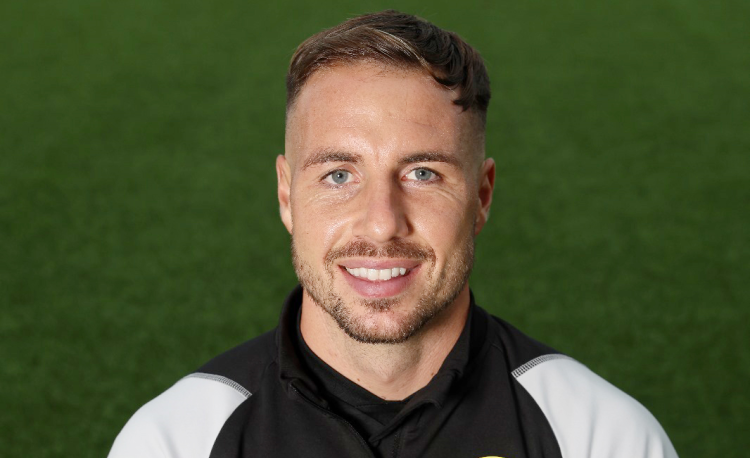Tactical positional play
This session focuses on our main principles in possession: positioning with support, width, in between, and depth within a team structure. We will start with drills involving low numbers and progress to 11v11 or as close to that as possible, depending on the number of players available.

| Area | Up to full pitch |
| Equipment |
Balls, bibs, flats, poles, mini goals, full size goal |
| No. of Players |
Up to 20 + 2 goalkeepers |
| Session Time |
Small rondo: Positional rondo: Three-quarter pitch game: 16mins plus breaks |
This session focuses on our main principles in possession: positioning with support, width, in between, and depth within a team structure. We will start with drills involving low numbers and progress to 11v11 or as close to that as possible, depending on the number of players available.
The practice sessions are all game-specific and involve opposed drills, avoiding unopposed practices. This approach stresses the players, requiring them to make game-like decisions within a team structure and in scenarios that closely resemble actual games.
We will run this session at least once a week, either on our in-possession day or during certain parts of the session on MD-1 and MD+1 using certain components.
All the movements and rotations we want to see from the players have been embedded during the early parts of the season and within video analysis. We are now giving the players the freedom and responsibility to make their own decisions, discover where the space is, and identify areas where we can inflict the most damage on the opposition, as the game is ever-changing during the 90 minutes.
SMALL RONDO
Set up in three groups for 5v2 rondos in an area of 8x16m. Pressing players press for four minutes altogether. Side players take one and two touches, the middle players have two touches maximum [1]. If the possession players make 12 passes then pressing players do 10 press-ups. If possession players fail to get 12 passes, then they do 10 press-ups.
This is essentially a passing warm-up but with opposition to test the players’ touch, choice of pass, and decision-making. If executed at a high standard, the pressing players should not get a touch.
[1]
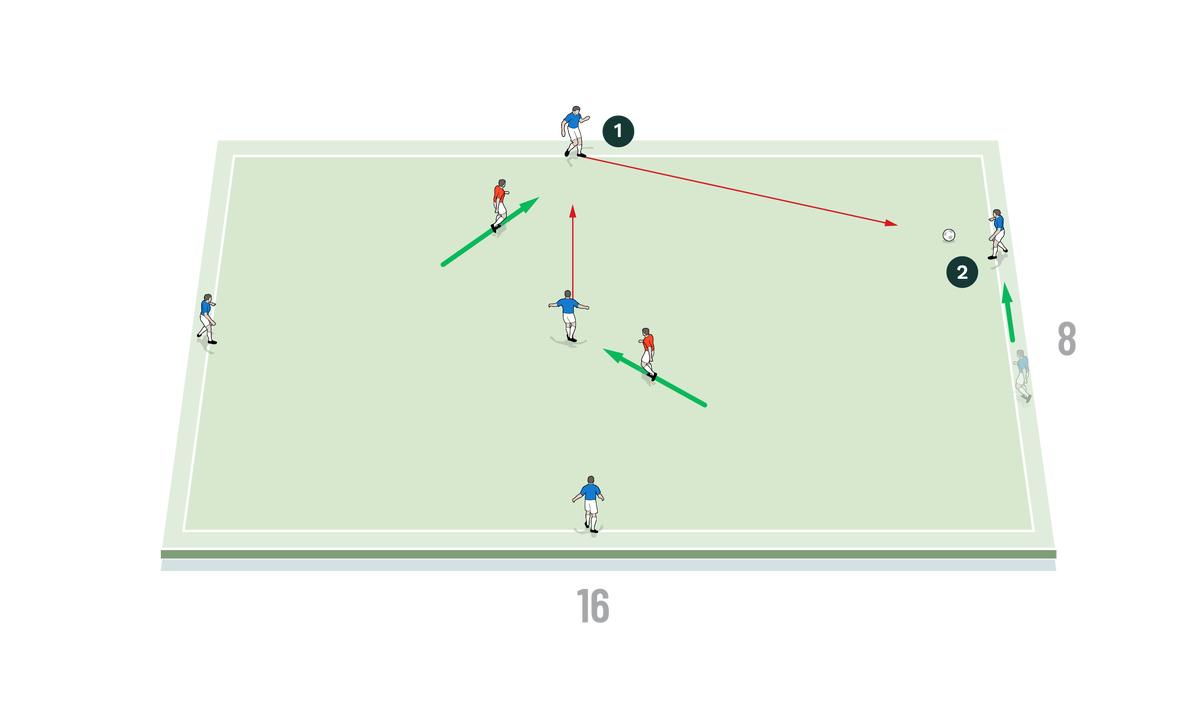
-
One touch maximum
-
Two touches maximum
POSITIONAL RONDO
Set up in 10v7 plus one goalkeeper. We run this exercise four times for three minutes in an area 40x44m. The ball starts with the coach who plays into a blue centre-back, blues attack towards goal and you set up in your team’s formation (4-2-3-1 in this example). Work the ball to play in behind for a first-time cross into the box and finish. The red team press with seven players, three in the defensive half, four in the attacking half. (You can set up with consideration to the next opposition.)
If the reds win ball back, they try and score into the mini goals [2]. One defender can track back when the defensive line is broken.
You can progress this in a number of ways: add an extra red to press, two reds can defend the box, blue 6 and 10 can rotate.
We need to think about the positioning of support, wide, in between and deep. If there is no pressure on the ball then players hold positions; if there is pressure then players come alive to get free. If the player on the ball is facing forward with time, then we need runs in behind.
[2]
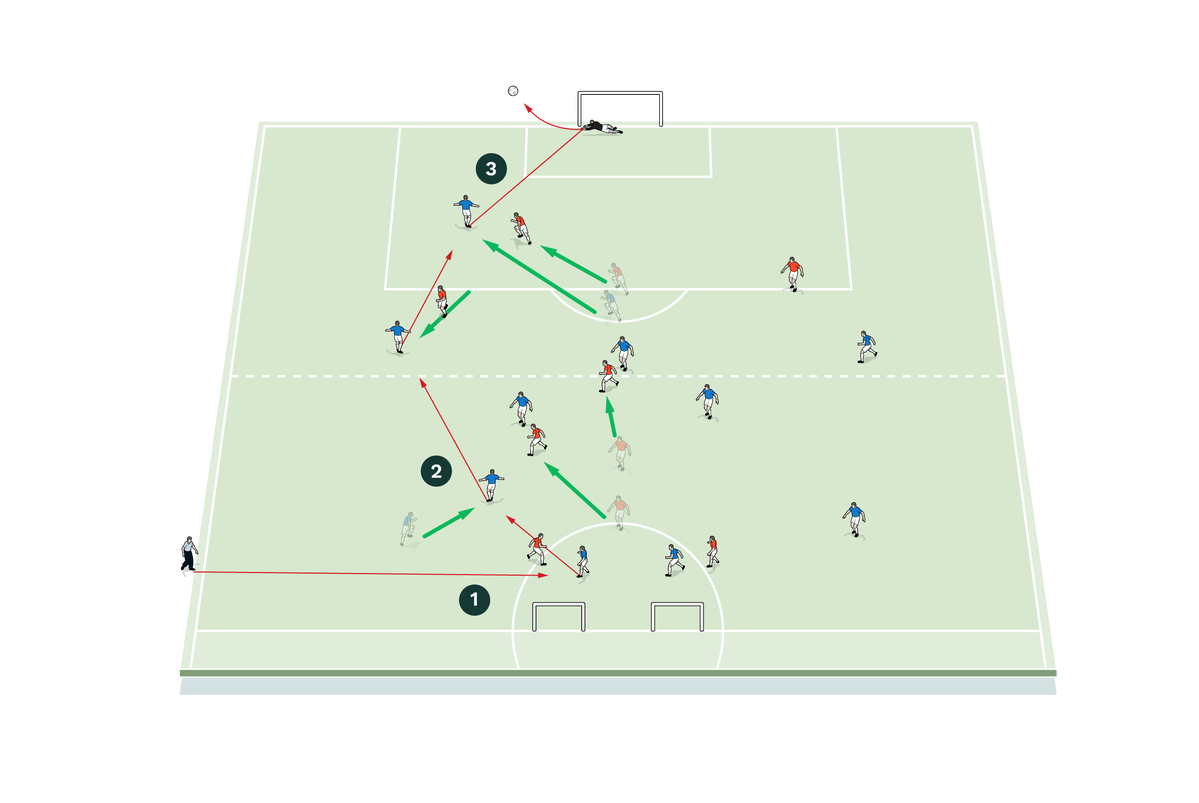
-
Coach plays into blue centre-back
-
Blues attack towards goal, set up in your team’s formation (4-2-3-1 in this example)
-
Blues work the ball to play in behind for first-time cross into box and finish
THREE-QUARTER PITCH GAME
Set up on roughly a three-quarter pitch in a 10v9 plus a goalkeeper for each side. We will run this for four rounds of four minutes; after two rounds, add an extra red player to make 10v10. The blues always start with ball on restarts and look to attack goal to break the defensive line [3a].
[3a]
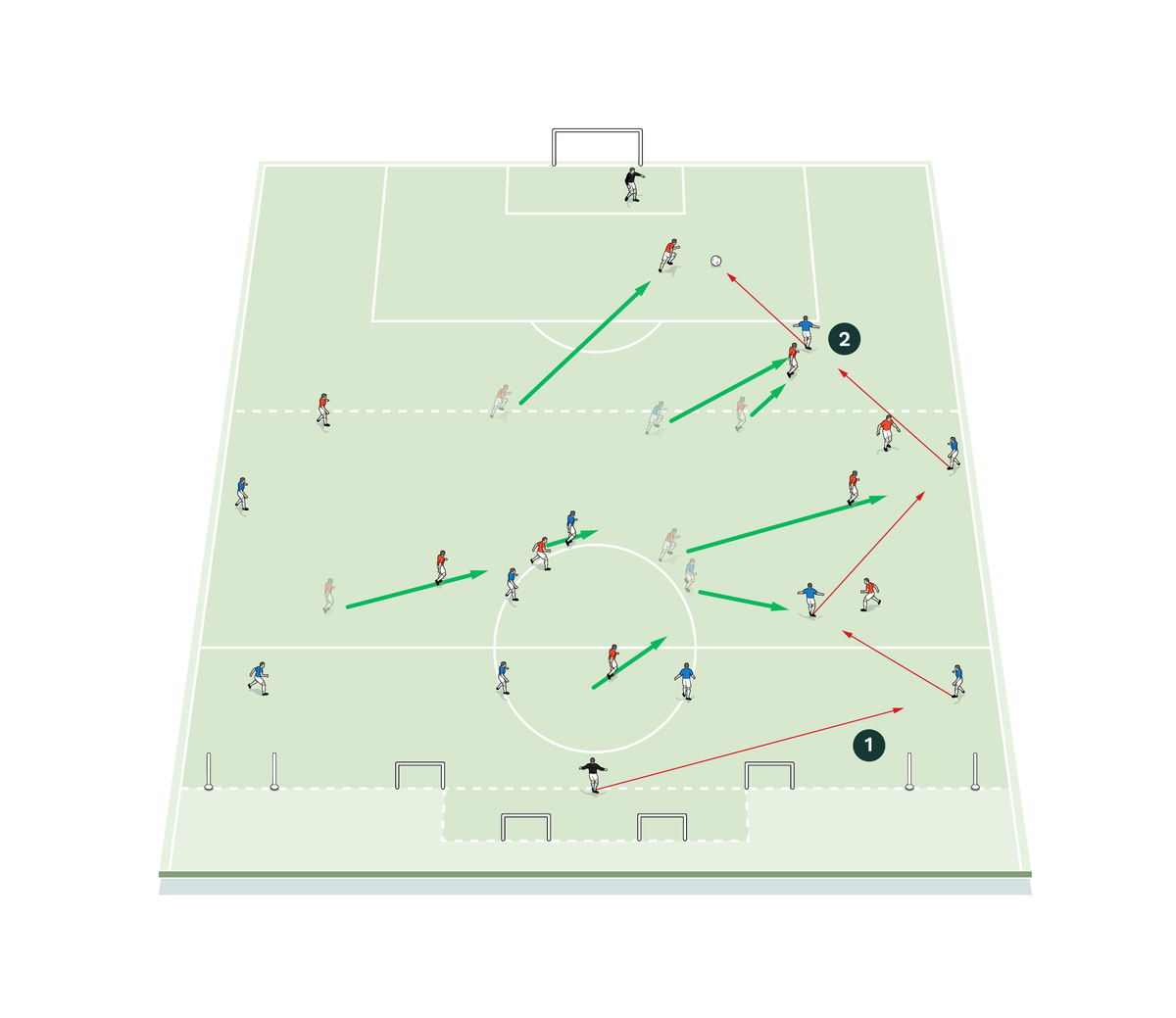
-
Blues always start with ball on restarts
-
Blues attack goal to break defensive line
Three or four players should make the box. We run with multi ball on sidelines for throw-ins, with four seconds allotted for each throw. If the reds win the ball back, they should aim to score into the mini goal or dribble through the wide poles [3b]. Two reds can track back and defend the cross. Reds must always start the defensive line on the white line and can’t drop back until the line is broken. When blues lose the ball, they should look to regain by either penetrating the opposition’s disorganisation or gain control to regain positioning. The defence should be structured to protect the middle and show outside to win individual duels.
[3b]
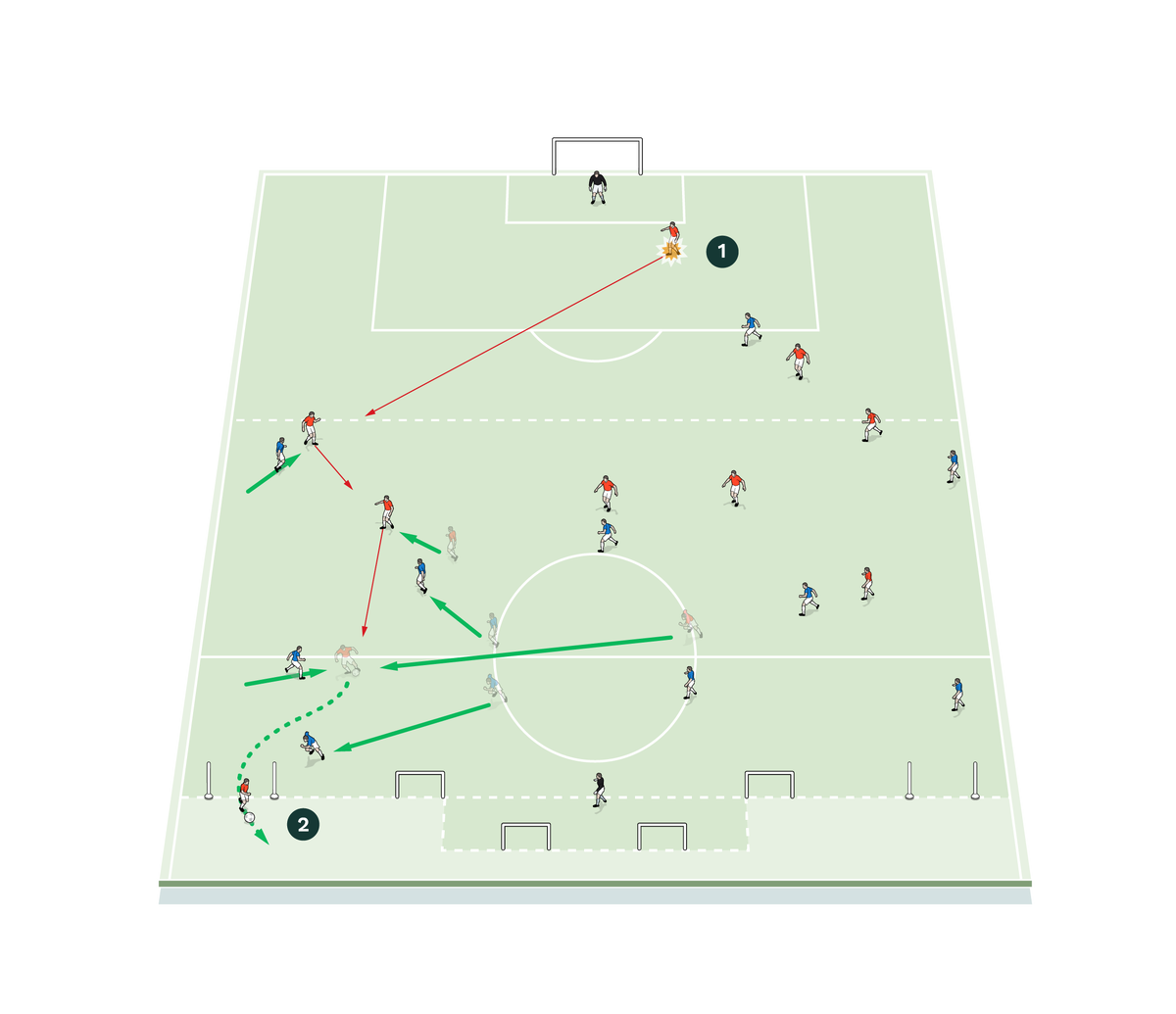
-
Reds win the ball back
-
Reds aim to score into mini goal or dribble through wide poles
COACHING POINTS
What are the key things to look out for technically and tactically?
We are looking for the players to be positionally disciplined, occupying the spaces on the pitch to exploit the spaces in between or beyond. Wingers should stay high, on the last line, always offering a threat in behind, with the three central midfielders rotating if individually marked.
When central defenders are in possession and not pressured, we hold our positions.
When we are provoked and get pressed, we come alive to create angles to receive the ball. If the player on the ball has time and is facing forward, we always need one or two forward runs in behind to stretch opponents, exploit space in behind, or create space in front.
When we do get in behind, we want early crosses and our attackers to attack the box and space.
What are the typical mistakes players might make and how do I avoid them?
Players tend to get attracted to the ball and not occupy space as they don’t trust their team-mates to find them with the ball. Wide players also tend to drop too deep and don’t maintain a threat in behind, failing to understand that an unselfish run in behind can create space for another team-mate.
Editor's Picks
Attacking transitions
Deep runs in the final third
Using the goalkeeper in build-up play
Intensive boxes drill with goals
Penetrating the final third
Creating and finishing
My philosophy
Pressing initiation
Compact team movement
Coaches' Testimonials

Alan Pardew

Arsène Wenger

Brendan Rodgers

Carlos Carvalhal

José Mourinho

Jürgen Klopp

Pep Guardiola

Roy Hodgson

Sir Alex Ferguson

Steven Gerrard
Coaches' Testimonials

Gerald Kearney, Downtown Las Vegas Soccer Club

Paul Butler, Florida, USA

Rick Shields, Springboro, USA

Tony Green, Pierrefonds Titans, Quebec, Canada
Join the world's leading coaches and managers and discover for yourself one of the best kept secrets in coaching. No other training tool on the planet is written or read by the calibre of names you’ll find in Elite Soccer.
In a recent survey 92% of subscribers said Elite Soccer makes them more confident, 89% said it makes them a more effective coach and 91% said it makes them more inspired.
Get Monthly Inspiration
All the latest techniques and approaches
Since 2010 Elite Soccer has given subscribers exclusive insight into the training ground practices of the world’s best coaches. Published in partnership with the League Managers Association we have unparalleled access to the leading lights in the English leagues, as well as a host of international managers.
Elite Soccer exclusively features sessions written by the coaches themselves. There are no observed sessions and no sessions “in the style of”, just first-hand advice delivered direct to you from the coach.








